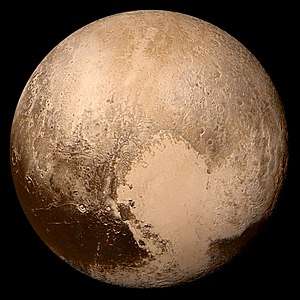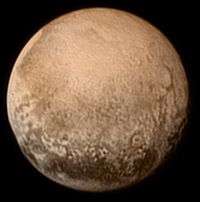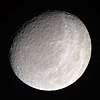Kerberos (moon)
.jpg) Kerberos imaged by New Horizons on 14 July 2015 from a distance of 396,100 km | |
| Discovery[1] | |
|---|---|
| Discovered by | Showalter, M. R. et al. |
| Discovery date |
28 June 2011 (verified 20 July 2011) |
| Designations | |
| Pronunciation | /ˈkɜːrbərəs/ |
Named after | Cerberus |
| S/2011 P 1, P4 | |
| Orbital characteristics[2] | |
| 57783±19 km[3] | |
| Eccentricity | 0.00328 ± 0.00020 |
| 32.16756±0.00014 d[3] | |
| Inclination | 0.389°±0.037° |
| Satellite of | Pluto |
| Physical characteristics | |
| Dimensions | 19 × 10 × 9 km[4] |
| Mass | 1.65×1016 kg[notes 1] |
| 5.31 ± 0.10 d (chaotic)[4] | |
| Albedo | 0.56 ± 0.05[4] |
| 26.1±0.3[1] | |
|
| |
Kerberos is a small natural satellite of Pluto, about 12 km (7.5 mi) in its longest dimension. It was the fourth moon of Pluto to be discovered and its existence was announced on 20 July 2011.[1] It was imaged, along with Pluto and its four other moons, by the New Horizons spacecraft in July 2015.[6] The first image of Kerberos was released to the public on 22 October 2015.[7]
History
Discovery

Kerberos was discovered by the Pluto Companion Search Team using the Hubble Space Telescope on 28 June 2011, using the Wide Field Camera 3, during an attempt to find any rings that Pluto might possess.[notes 2][10] Further observations were made on 3 and 18 July 2011 and Kerberos was verified as a new moon on 20 July 2011.[1][11] It was later 'precovered' (identified in earlier archival Hubble images) in images from 15 February 2006 and 25 June 2010.[1] Kerberos's brightness is only about 10% of that of Nix, and it was only found because the discovery team took 8-minute exposures; earlier observations had used shorter exposures.[12]
The provisional designation of the satellite varied based on the source used. The International Astronomical Union announced it as S/2011 (134340) 1,[1] whereas the New Horizons mission website announced it as S/2011 P 1.[13]
Naming
Upon discovery, Kerberos received the minor planet designation S/2011 (134340) 1 because it was the first satellite (S) discovered orbiting minor planet (134340) in 2011. It was initially called "P4", meaning the fourth Plutonian moon to be discovered.
The convention for naming Plutonian moons is to use names associated with the god Pluto in classical mythology. To decide on names for P4 and P5, Mark Showalter and the SETI Institute, on behalf of the discovery team, conducted a non-binding Internet poll in 2013, in which the general public was invited to vote for their favorite names. The public could choose from a selection of Greek mythological names related to the god Pluto, or could propose their own names.[14] After the initial announcement, William Shatner, the actor who played Captain James T. Kirk in the Star Trek franchise, proposed the names Vulcan and Romulus, ostensibly referring to the fire god Vulcan (a nephew of Pluto), and to Romulus the founder of Rome, but also alluding to the fictional planets of Vulcan and Romulus in the Star Trek universe.[15][16] The 'Romulus' suggestion was discounted, because there is already an asteroid moon of that name,[17] but Vulcan won the poll after Shatner tweeted about it, with Cerberus, (the dog that guards Pluto's underworld) coming second and Styx (the goddess of the river of the underworld) coming third. The winning names were submitted to the International Astronomical Union.[16] However, 'Vulcan' was unacceptable to the IAU because it was not the name of an underworld deity and had already been used for a hypothetical planet inside the orbit of Mercury, as well as having given its name to the hypothetical vulcanoids.[15][18] Cerberus is already the name of an asteroid, 1865 Cerberus, but the Greek form of the name, Kerberos, was acceptable to the IAU.[19]
On 2 July 2013, the IAU announced that it formally approved the names Kerberos for P4 and Styx for P5.[20][21]
The names of features on the bodies in the Pluto system are related to mythology and the literature and history of exploration. In particular, the names of features on Kerberos must be related to dogs from literature, mythology and history.[22]
Physical properties
Kerberos has a double-lobed shape and is approximately 7.4 mi (11.9 km) across in its long dimension and 2.8 mi (4.5 km) in its shortest dimension. Kerberos has an albedo similar to the other three small moons. Until the New Horizons flyby it was thought that Kerberos was larger and darker.[23] Like the other small Plutonian satellites, Kerberos is not tidally locked; its rotational period was about 5.33 days at the time of the New Horizons flyby, although this varies quickly over geological timescales.[24]
Orbit
Observations indicate a circular, equatorial orbit with a radius of approximately 58,000 km (36,000 mi).[2] Kerberos orbits between Nix and Hydra and makes a complete orbit around Pluto roughly every 32.1 days.[1][12] This period is close to a 1:5 orbital resonance with Charon, with the timing discrepancy being about 0.7%.[notes 3] As with the near resonances between Nix or Hydra and Charon (1:4 and 1:6, respectively), determining how close this relationship is to a true resonance will require more-accurate knowledge of Kerberos's orbit, in particular its rate of precession.
Origin
Like Pluto's other satellites,[25] it is suspected that Kerberos coalesced from the debris of a massive collision between Pluto and another Kuiper belt object, similar to the giant impact thought to have created the Moon.[10]
Exploration
The New Horizons spacecraft took images of Kerberos during its flyby of the Pluto system on 14 July 2015. Three months later, on 22 October, the first image of the moon was published. It is the last moon to have its picture released.[7]
In science fiction
Author Edmond Hamilton referred to three moons of Pluto in his 1940 novel Calling Captain Future, naming them Charon, Styx, and Cerberus.[26]
Kerberos is the site of a crucial event in Voltron: Legendary Defender, in which Takashi Shirogane, Matt Holt, and Dr. Sam Holt, the crew of an exploratory mission from Earth, are abducted and taken prisoner by the Galra Empire, an evil race of aliens set on conquering the rest of the known universe.
Notes
- ↑ Derived from the published value of GMKerberos = 0.0011±0.0006 km3/s2 [5] and the relationship MKerberos = GMKerberos/G
- ↑ The search for rings was motivated in part by a desire to avoid damage to New Horizons when it passed through the Pluto system in July 2015.[8][9]
- ↑ where is Kerberos's period and is Charon's period.
References
- 1 2 3 4 5 6 7 Showalter, M. R.; Hamilton, D. P. (2011-07-20). "New Satellite of (134340) Pluto: S/2011 (134340) 1". Central Bureau for Astronomical Telegrams. International Astronomical Union. Retrieved 2011-07-20.
- 1 2 Showalter, M. R.; Hamilton, D. P. (3 June 2015). "Resonant interactions and chaotic rotation of Pluto's small moons". Nature. 522 (7554): 45–49. Bibcode:2015Natur.522...45S. doi:10.1038/nature14469. PMID 26040889.
- 1 2 "DPS 2015: Pluto's small moons Styx, Nix, Kerberos, and Hydra [UPDATED]". www.planetary.org.
- 1 2 3 "2016 Lunar & Planetary Science Conference by National Institute of Aerospace".
- ↑ Brozović, Marina; Showalter, Mark R.; Jacobson, Robert A.; Buie, Marc W. (January 2015). "The orbits and masses of satellites of Pluto". Icarus. 246: 317–329. Bibcode:2015Icar..246..317B. doi:10.1016/j.icarus.2014.03.015.
- ↑ Cain, Fraser (2008). "Pluto's Moon Nix".
- 1 2 Talbert, Tricia. "Last of Pluto's Moons – Mysterious Kerberos – Revealed by New Horizons". NASA. Retrieved 2015-10-23.
- ↑ Wall, M. (2011-07-20). "New Pluto Moon Foreshadows More Surprises for NASA Probe En Route". Space.com. TechMediaNetwork. Retrieved 2011-07-21.
- ↑ McKee, M. (2006-02-22). "Rings of ice and dust may encircle Pluto". www.newscientist.com. New Scientist. Retrieved 2011-07-21.
- 1 2 Boyle, A. (2011-07-20). "Scientists spot Pluto's fourth moon". Cosmic Log on msnbc.com. msnbc.com. Retrieved 2011-07-20.
- ↑ "Pluto Has Another Moon, Hubble Photos Reveal | Dwarf Planet Pluto | Pluto's Moons". Space.com. Retrieved 2012-07-12.
- 1 2 Lakdawalla, E. (2011-07-20). "A fourth moon for Pluto". planetary.org/blog. The Planetary Society. Retrieved 2011-07-20.
- ↑ New Horizons news, Johns Hopkins University Applied Physics Laboratory, "Fourth Moon Adds to Pluto's Appeal", 20 July 2011
- ↑ "Ground Rules". Retrieved 12 May 2013.
- 1 2 Marcia Dunn (25 February 2013). "Capt. Kirk's Vulcan entry wins Pluto moons contest". San Francisco Chronicle. Associated Press. Retrieved 25 February 2013.
- 1 2 Alexandra Witze (2013-04-23). "Moon and planet names spark battle : Nature News & Comment". Nature.com. Retrieved 2013-07-06.
- ↑ "'Vulcan' tops poll for moon name". 3 News NZ. 26 February 2013.
- ↑ Miriam Krame (25 February 2013). "'Vulcan' and 'Cerberus' Win Pluto Moon Naming Poll". SPACE.com. Retrieved 25 February 2013.
- ↑ Rice, Tony. "Kerberos and Styx named as moons of Pluto". WRAL.
- ↑ "Names for New Pluto Moons Accepted by the IAU After Public Vote". IAU. 2 July 2013. Retrieved 2 July 2013.
- ↑ "Pluto's Smallest Moons Receive Their Official Names". SETI Institute. 2 July 2013. Retrieved 2 July 2013.
- ↑ "International Astronomical Union - IAU". www.iau.org.
- ↑ "Kerberos Revealed". pluto.jhuapl.edu. NASA/Johns Hopkins University Applied Physics Laboratory/Southwest Research Institute. October 22, 2015. Retrieved October 22, 2015.
- ↑ "DPS 2015: Pluto's small moons Styx, Nix, Kerberos, and Hydra [UPDATED]". www.planetary.org.
- ↑ Stern, S. A.; Weaver, H. A.; Steff, A. J.; Mutchler, M. J.; Merline, W. J.; Buie, M. W.; Young, E. F.; Young, L. A.; Spencer, J. R. (2006-02-23). "A giant impact origin for Pluto's small moons and satellite multiplicity in the Kuiper belt" (PDF). Nature. 439 (7079): 946–948. Bibcode:2006Natur.439..946S. doi:10.1038/nature04548. PMID 16495992. Archived from the original (PDF) on 2012-01-19. Retrieved 2011-07-20.
- ↑ Codex Regius (2016). Pluto & Charon. CreateSpace Independent Publishing Platform. ISBN 978-1534960749.


.jpg)
